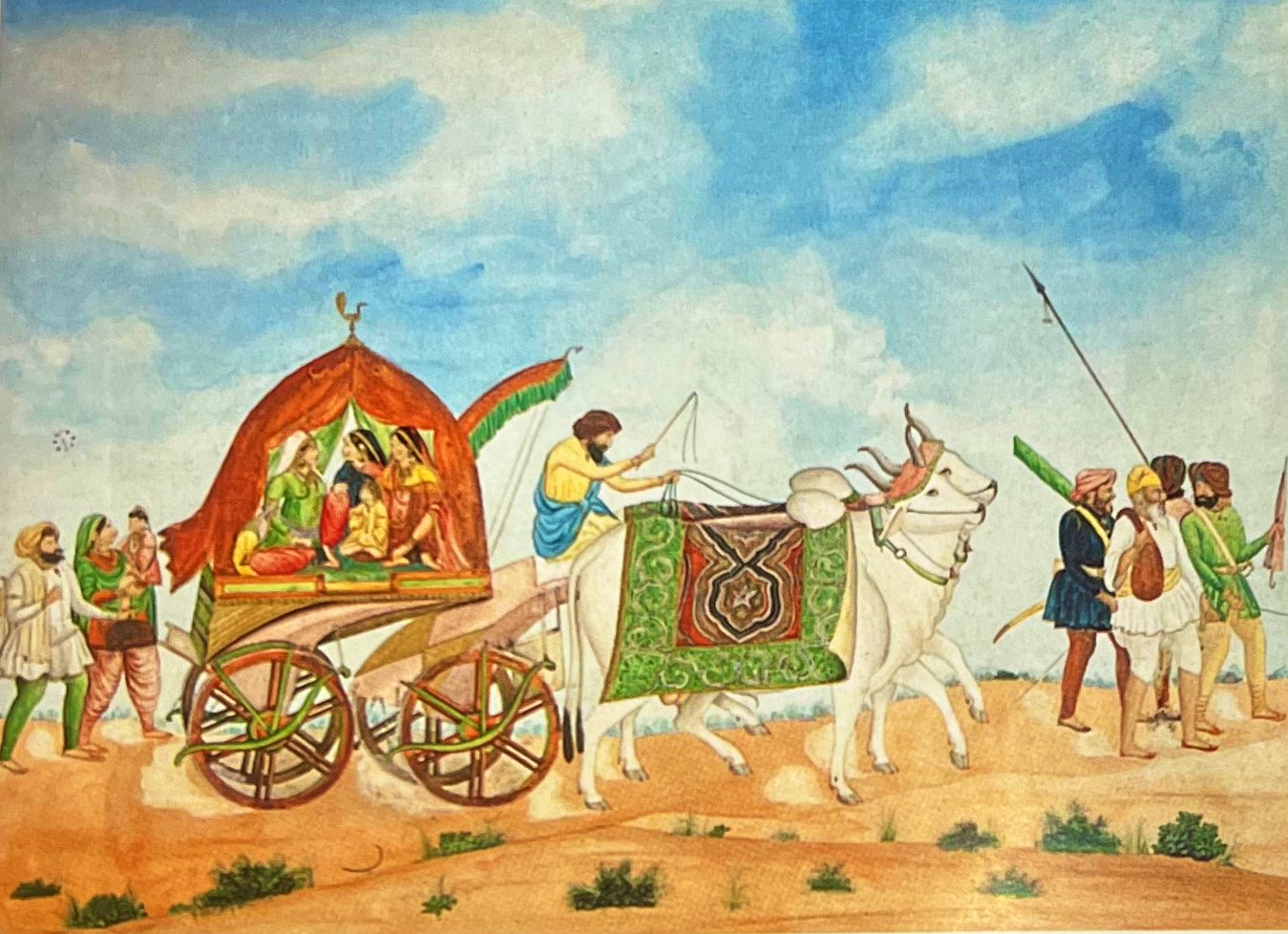
“Impossibility” is a word that Rajbir Singh Judge returns to again and again in Prophetic Maharaja: Loss, Sovereignty, and the Sikh Tradition in Colonial South Asia. Judge explores the narratives that accumulated around “loss” and “sovereignty” in attempts to re-establish the exiled Sikh ruler, Duleep Singh (1833–1898). Duleep Singh’s unsuccessful attempts to regain his throne has inspired novels, biographies, visual art, and more recently, tourism. Several scholarly accounts of his life also exist, attempting to tame wildly different accounts of his life in the colonial archive and postcolonial imaginations. Ranjeet Singh (d. 1839), Duleep Singh’s father, was once a formidable check to British colonial expansion. But by 1849 internal feuds and two Anglo-Sikh wars led swiftly to the colonization of Punjab. Duleep Singh, the surviving minor son and heir of Ranjit Singh, would go into exile in Britain.
Judge’s book explores both the “impossibility” for colonial sources or Duleep Singh’s own papers to offer satisfyingly coherent narratives that could explain the disparate efforts to re-establish the old Sikh kingdom. Instead the book focusses on communities and individuals who joined Duleep Singh in his quixotic campaign to regain his throne. This book is an exploration of loss, and more specifically, the loss of sovereignty and Sikh Raj (rule) for Punjab’s colonized subjects. More poignantly Judge reveals the complications posed by such losses for postcolonial communities attempting to define themselves.
This book is also a remarkable reading of Sikhi, Sikh ethical teachings, which helps frame how we can understand the motivations of Duleep Singh and his supporters, and also the relationship between communities and their pasts. In refusing coherence and recuperation Judge offers glimpses of contingent futures imagined by Duleep Singh’s supporters, plumbing the “epistemic murk” of the colonial archives explored in the book. The book itself is constructed along themes that pry open the question of what the “mute eloquence” of those unheard supporters and Duleep Singh himself might contain. As Judge observes:
Perhaps we have gone too far, evading Duleep Singh in a manner that, as Jacques Rancière notes, ‘The verbiage of every proffered message, in favor of the mute eloquence of who is not heard.’ Proposing loss as the final demarcation of Duleep Singh, can function in such a manner, reducing his historical being into an impossibility, always already unable to be signified (88).
In other words, this is less a book about Duleep Singh as an individual and more about the multiple “shuttling subalterns” that are discoverable in the archival traces of an incomplete archive. These traces are revealed in the thematic perspectives that Judge employs to understand Singh’s attempts to reclaim Khalsa Raj: “community,” “the public,” “conversion,” “rumors,” “reform,” and finally, “failure.” These themes dominate scholarly debates about Punjab’s religious communities in this period of colonial reform and nineteenth-century print culture. Each chapter dives into gnarly issues, and invites the reader to sit with the tensions contained in these unresolved threads.
An acknowledgment of “impossibility” and the refusal to offer a homogenous historicized narrative is itself an ethical stance. Afterall, the fragments and sources that offer the lure of coherence emerge from archives constructed to foreclose expansive readings. Readings of what it means to live in community inhabit a sovereign silence in order to hear what cannot be heard, or to see community as a path, a process of becoming, or a panth, rather than a body with defined boundaries that can be contained in recorded time and history. Earlier chapters offer tantalizing readings of one of the central “impossibilities” of the book, that the very moment an attempt is made to define what constitutes a community or force it to cohere, the very notion of community slips away.
The fact that the paranoid fever dreams of the colonial intelligence system provide much of Duleep Singh’s archive starkly reveals the accumulated “epistemic murk” that clouds the very moment of recording “facts,” “events,” for an authorizing “authority” or to a knowing “public.” Each is constructed and re-ordered through an extractive system of collecting rumors, betraying trusts, and also doing violence to the forms of knowledge that this “intelligence” conveys.
But we should ask: Is this hostile archive the only repository for such questions? As a historian of the eighteenth century, the mission to regain the throne of Duleep Singh has always filled me with astonishment both because of the sheer impossibility of the project itself and what it says about the predictability and limitations of our own scholarly understandings of “Raj.”
The English word “sovereignty” only partially captures the meanings indicated in “Raj.” For the dispossessed communities in Colonial Punjab, Multan, and Kashmir, the experience of Khasla Raj in the nineteenth century were varied, uneven, and still gelling into very different narratives. It is important to remember that Ranjit Singh’s state never fully delivered the promise of Khalsa Raj for many Sikhs. Ranjit Singh’s claim to embody “Sikh Raj” was an uncomfortable grafting of human ambition into forms of ethical attunement, community, and service (seva) that sat uneasily, as Judge himself points out, with the humility to be modelled by a Sikh.
That the aspirations, lives, and resources of many of the people discussed in this book came to be risked for Duleep Singh’s impossible dream is astonishing. Why astonishing? First, to even frame a recovery of Khalsa Raj as a recovery of the lost throne of Lahore for Duleep Singh, groups that once widely shared a very different vision of Khalsa Raj all had to coalesce around this prince. It is also astonishing because Duleep Singh’s supporters came to believe that only a male prince of Ranjit Singh’s lineage could perform the function of Raj for Punjabis, Sikhs, and their colonial diasporic networks. Dynastic succession was still a contested political form in Punjab mere decades before, and male succession was jostled periodically. Yet, neither Duleep Singh’s formidable mother, Rani Jindan,[1] nor his daughters, who embraced radical politics to a much greater degree than his sons, could fill that role for most Punjabis by this point. To point to these well-known, familiar, and entrenched patriarchal and lineage constraints on what had been a century earlier an expansive promise of Khalsa Raj is to point to different archives than the one explored in this book. These include local histories authored in Punjabi as well as Persian, commemorative accounts of battels (jangname), and other works of memory and history that still await further study. Many only exist as manuscripts. These reveal many different debates, accusations of betrayal, usurpations, and hijackings of the impossibly wide promise of Raj, and not always in its reading of sole “sovereignty” but also as shared rule by multiple communities, and their mutually acknowledged independence in precolonial Punjab.

To encounter Raj in the nineteenth century is to trace its narrowing vision. However, even under colonization, elements of the previous expansive vision remained, whether it was in the counternarratives of the minor landed Sikh families, or the kathas and narrative stories still being produced in the intellectual centers of production in numerous taksals, bungas, and less visible rural locations. Their manuscript traces remain, even if they remain marginalized in scholarly accounts of the period, as Jwala Singh’s recent dissertation suggests.
In other words, I would argue that the “carceral operation of history” that Judge refers to at the end of the book does not encompass all the forms of historical narrativization and commemoration in the multilingual networks linked with Punjab, nor should the practice of history in the academic profession be reduced to narrative coherence in attempting to grapple with the past, although sadly this is what it often ends up doing.
This is why despite Judge’s well-signposted refusal to historicize, or to offer as he frames it “a proper burial through the conquest of time” (16), there is room to embrace the ethics of the vision in this book while still historicizing profusely and even counter-historicizing. It is possible to contextualize ideas, events, people, not simply within the temporal limits of their perceived placement in linear time, but in their engagement and entanglements with the expansive temporal frameworks that exist in their literary, theological, and imaginative worlds. A history that can only capture the history “of what happened” is truly an impoverished history. To embrace all these requires a continued movement between the perception and subjective experience of lived lives, their material realities, and simultaneously, their refusal to be limited by our own perceived temporal limits in modernity.
Why should “historicization” imply a reduction? Are we not trapping our notion of history in a very nineteenth-century perception of what history ought to do and ought to be? If history is not to be reduced to a carceral practice, is it not time we let go of the limiting frames of a singular narrative? Yet, to grapple with this profusion of perspectives, are we not forced to engage with the multiple smaller Sikh chiefs, soldiers, women, and many non-Sikh communities and the very forces that attempted to limit, discipline, and tame their existence? The colonial archive is not where those will be found.
The subaltern will never speak if the only archives through which we seek to engage with the “mute eloquence of who is not heard” is hostile to that voice. Or if the subaltern as a concept is frozen and fetishized into a binary of elite and non-elite that cannot account for either the large or more nuanced plays of relative power that make and unmake social hierarchies. So, while I applaud the stimulating methodology of the book and its ethical stance, I also offer a dissenting perspective of what history is and can be. I remain profoundly appreciative of Judge’s call to see our engagement with the past as a “site of learning that is necessarily out of joint (176).” But let us also consider those other archives and their multiplicity of temporary framings, viewpoints, and unresolvable contentions.
[1] Priya Atwal, Royals and Rebels, 193.

